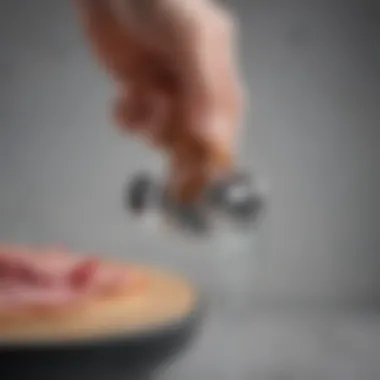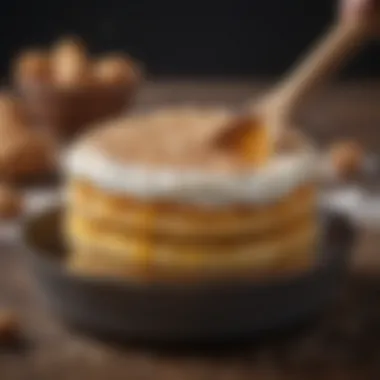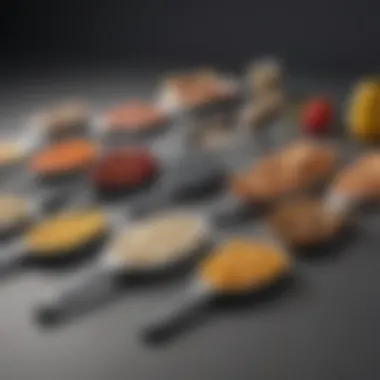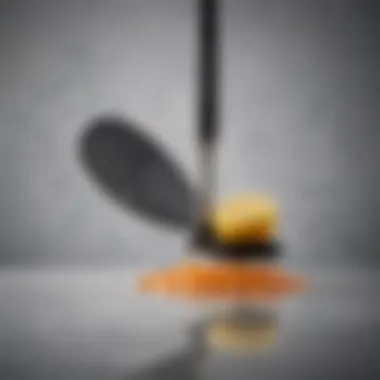Exploring the Paddle Attachment: Features & Uses


Intro
The paddle attachment is one of the essential tools for anyone who enjoys cooking and baking. It is specifically designed for stand mixers, facilitating the mixing of various ingredients to achieve the desired texture and consistency. Understanding its features and applications is crucial for both home cooks and professional chefs. This attachment enhances the efficiency of culinary tasks, simplifies processes, and can help create more complex dishes with less effort.
Recipe Overview
The paddle attachment can be used in numerous recipes, but it shines particularly in tasks such as mixing cake batter, cookie dough, and even whipped cream.
Brief Summary of the Recipe
Using the paddle attachment makes it easier to combine ingredients thoroughly without over-mixing. The even mixing helps in achieving uniform results, which is especially important in baking. Additionally, the sturdy design of the paddle allows for handling heavy mixtures, reducing the physical strain on the user.
Key Ingredients and Tools Needed
- Stand mixer: A quality stand mixer is needed to utilize the paddle attachment effectively.
- Paddle attachment: This is specifically designed for mixing tasks.
- Ingredients: Depending on the recipe, key ingredients may include flour, sugar, eggs, butter, and any additional flavors or spices.
Step-by-Step Instructions
Using the paddle attachment is straightforward, but certain steps can help ensure success.
Detailed Cooking Steps
- Prepare ingredients: Gather all necessary ingredients and measure them accurately.
- Attach the paddle: Secure the paddle attachment to the stand mixer according to the manufacturer's instructions.
- Mix dry ingredients: In a separate bowl, combine dry ingredients like flour, baking powder, and salt to ensure even distribution before mixing with wet ingredients.
- Cream butter and sugar: Using the stand mixer on medium speed, combine softened butter and sugar until light and fluffy, usually about 3-5 minutes.
- Add eggs: Slowly add eggs, one at a time, ensuring they are fully mixed after each addition.
- Incorporate dry ingredients: Gradually add the dry mixture into the wet ingredients. Mixing on low speed prevents flour clouds and ensures even blending.
- Mix until combined: Use the paddle until all ingredients are just combined. Avoid over-mixing, or the final product may become tough.
Tips for Successful Execution
- Room temperature ingredients: Ensure butter and eggs are at room temperature for better mixing.
- Scrape the bowl: Occasionally stop the mixer to scrape down the sides of the bowl. This helps achieve a uniform mixture.
- Avoid over-mixing: As mentioned earlier, over-mixing can negatively affect the texture.
The paddle attachment is ideal for preparing batters and doughs that require a gentle touch. It allows for incorporating air efficiently, resulting in lighter baked goods.
Understanding the paddle attachment can significantly enhance one's culinary skills. It is not merely a tool; it is an essential piece of equipment that opens a world of possibilities in the kitchen. The very features that define the paddle attachment—efficiency, versatility, and ease of use—allow cooks at any level to produce high-quality results in their culinary endeavors.
Preamble to the Paddle Attachment
The paddle attachment is a fundamental component in the repertoire of kitchen tools, particularly for those who frequently use stand mixers. Understanding this attachment encompasses many aspects, including its design, uses, and the impact it has on food preparation efficiency. Culinary enthusiasts and professionals alike can leverage the advantages offered by the paddle attachment to enhance mixing tasks. By gaining a deeper insight into the features and applications of this tool, one can truly appreciate its versatility.
Defining the Paddle Attachment
The paddle attachment is a specialized tool designed to perform various mixing functions in stand mixers. It features a broad, flat base with a shape that allows it to effectively blend ingredients. This design is particularly effective for creaming butter and sugar, mixing cake batter, and preparing cookie dough. Unlike whisks that aerate and beat, the paddle gently combines ingredients, making it ideal for denser mixtures. The paddle's ability to reach all areas of the mixing bowl ensures that ingredients blend uniformly. This efficiency allows for a smoother, consistent texture in the final product.
Historical Context and Evolution
The paddle attachment, while widely used today, has evolved significantly since its introduction. Early mixers primarily utilized manual whisking processes, limiting the speed and efficiency of mixing. As kitchen technology advanced, the first electrical stand mixers emerged in the early 20th century, introducing more effective mixing methods. The paddle attachment gained prominence because it allowed for better consistency compared to traditional methods. Over time, various materials and design modifications have been implemented, enhancing the attachment's durability and efficiency. Today, the paddle attachment is commonly made from innovative and robust materials, making it a staple in kitchens globally.
"The paddle attachment is essential for achieving consistency in baking and culinary tasks."
In summary, the paddle attachment plays a crucial role in modern cooking and baking. By understanding its definition and historical background, one can better appreciate its importance in culinary applications.


Physical Characteristics
The physical characteristics of the paddle attachment are crucial to its overall functionality and effectiveness in the kitchen. Understanding these aspects aids users in optimizing their mixing experience while ensuring the longevity and durability of the attachment itself. By recognizing the materials and design features that contribute to the paddle attachment’s performance, cooks can leverage its capabilities more efficiently.
Materials Used in Construction
The material selection for paddle attachments is vital for both performance and durability. Most paddle attachments are made from stainless steel or a high-quality plastic that can withstand the stresses of mixing. Stainless steel is a popular choice due to its resistance to rust and staining. This makes it ideal for mixing a variety of ingredients without any concern for chemical reactions that could compromise flavor or texture.
Additionally, certain attachments can feature a non-stick coating, which aids in easy cleaning and reduces the chances of sticking during food preparation. It is important to avoid using metal utensils when working with non-stick materials to maintain their integrity. The choice of materials not only impacts how the paddle performs but also its ease of maintenance.
Design Elements and Features
The design elements of a paddle attachment play a significant role in its functionality. A well-designed paddle features a flat and broad mixing area that efficiently incorporates ingredients. This design allows for even mixing, which is critical in many culinary applications. The shape of the paddle also matters; it should effectively scrape the sides of the mixing bowl, ensuring all ingredients are combined thoroughly.
Another notable feature is the curvature of the paddle blade. A slight curve can enhance the mixing ability, making it easier to fold ingredients together, such as when making batter or dough.
Some paddle attachments include innovative features like flexible edges that provide even more thorough mixing and scraping. These smart designs maximize the paddle's efficiency, showcasing how careful thought in design can significantly improve user experience.
In summary, the physical characteristics of paddle attachments, including their materials and design features, contribute heavily to their effectiveness in culinary tasks. By understanding these components, users can choose and use paddle attachments better, ensuring successful outcomes in their culinary endeavors.
Functional Overview
Understanding the functional overview of the paddle attachment is essential to appreciate its invaluable role in the culinary world. The paddle attachment is more than just a tool; it is a key player in various mixing processes. Its design is tailored to accommodate a vast array of ingredients while ensuring effective amalgamation. This section illustrates why the paddle attachment is a favored choice among both professional and home cooks.
Primary Functions of the Paddle Attachment
The paddle attachment is primarily utilized for creaming, mixing, and blending. Its flat surface and rigid structure make it particularly suitable for tasks that require thorough incorporation of ingredients.
- Creaming Butter and Sugar: One of the fundamental uses of the paddle attachment is creaming butter and sugar. This process is vital for baking, as it introduces air into the mixture, resulting in a light and fluffy texture.
- Mixing Doughs: For denser mixtures like cookie dough or cake batter, the paddle attachment provides the necessary strength to combine flour, sugar, and fats effectively. It ensures a uniform consistency without overworking the dough.
- Incorporating Ingredients: When adding additional ingredients like chocolate chips or nuts, the paddle can evenly distribute them throughout the batter. This promotes an even texture and flavor in the final product.
Effectively, the paddle attachment's design facilitates these processes, reducing the effort needed to achieve the ideal blend. The importance of each function cannot be overstated, as they are foundational to obtaining optimal results in various recipes.
Comparing with Other Attachments
While the paddle attachment is versatile, it is useful to understand its distinction from other mixer attachments.
- Whisk Attachment: The whisk attachment, for instance, is designed specifically for incorporating air into mixtures, making it ideal for whipping egg whites or cream. However, it is not suited for thicker batters, as it may not produce the desired blending.
- Dough Hook: This attachment specializes in kneading dough, which requires a different type of motion and power. The dough hook excels at developing gluten, but it is not effective for light mixing tasks.
In brief, each attachment has its strengths tailored for specific culinary tasks. The paddle attachment stands out for its ability to handle a broad spectrum of mixing jobs, enhancing its practicality in a kitchen setting.
Benefits of Using the Paddle Attachment
The paddle attachment is a transformative tool in the kitchen. Understanding the benefits of using this attachment can elevate both the cooking and baking experience. The paddle attachment not only improves efficiency in mixing tasks but also offers versatility across a range of culinary applications. By utilizing this attachment, home cooks and professional chefs alike can achieve better outcomes in their recipes. Its design facilitates even mixing, which is essential for creating well-blended ingredients, whether in cookie batter or mashed potatoes.
Efficiency in Mixing
One of the primary advantages of the paddle attachment is its efficiency in mixing various ingredients. Unlike traditional mixing methods, which may require more effort and time, the paddle attachment streamlines the process, allowing for consistent results with less manual labor. This tool effectively mixes dry and wet components, ensuring a uniform consistency throughout.


For instance, when preparing batter for cakes, the paddle attachment combines flour, sugar, butter, and eggs seamlessly. The even mixing it offers minimizes the risk of overbeating, preserving the delicate balance of air within the mixture. This is particularly essential in baking, where precise ratios and textures can make or break a dish.
Also, utilizing the paddle attachment reduces the likelihood of needing to stop and scrape down the sides of the bowl. The design of the attachment helps to gather ingredients from all corners, enhancing productivity. This efficiency not only saves time but also contributes to a smoother workflow in the kitchen.
Versatility in Culinary Applications
Another key benefit of the paddle attachment is its versatility. It can be employed in a multitude of culinary tasks beyond simple mixing. From making dough for bread to whipping up creamy frosting, the paddle attachment shines in its ability to handle various textures and consistencies.
Some of the applications include:
- Baking: The attachment excels in whipping ingredients, which is crucial for creating light and fluffy baked goods.
- Mixing Dough: For recipes that require kneading or heavy mixing, the paddle attachment can easily handle thicker mixtures without undue strain.
- Hoisin Sauce or Marinades: The paddle can also mix wet and dry ingredients for sauces, ensuring even distribution of spices and flavors.
- Savory Dishes: The attachment is useful for combining ingredients for dips or spreads, making it easy to create rich textures without clumps.
In summary, the paddle attachment serves as a multifaceted tool that can adapt to various culinary experiments. This versatility encourages creativity in the kitchen, empowering cooks to try new recipes and techniques with confidence. Given the emphasis on both efficiency and flexibility, the paddle attachment stands as a must-have in the world of culinary tools.
The paddle attachment is a valuable asset in any kitchen, offering efficiency in mixing and unmatched versatility for countless culinary applications.
Best Practices for Paddle Attachment Use
Using a paddle attachment correctly can significantly enhance your culinary experience. The paddle attachment is versatile, but understanding how to use it effectively is crucial. Best practices ensure consistency in results and minimize your workload in the kitchen. Adjusting how you use it can lead to better textures and flavors in your dishes. Three main areas to focus on are speed settings, mixing techniques, and cleaning procedures.
Understanding Speed Settings
Speed settings play a key role in using the paddle attachment effectively. Each mixture has its ideal speed to achieve the best results. Generally, there are three categories of speed: low, medium, and high.
- Low Speed: Use low speed for combining dry ingredients or fragile mixtures like whipped cream. It prevents overmixing, minimizing air incorporation and maintaining a gentle texture.
- Medium Speed: Ideal for creaming butter and sugar, it allows for air incorporation, which is essential for light and fluffy mixtures. This is also good for mixing batters and doughs where you want some texture.
- High Speed: High speeds are best for denser mixtures, such as bread dough. It fully integrates the ingredients and ensures a smooth, elastic dough.
Knowing when to adjust the speed makes a big difference in the outcomes of recipes. Always start mixing at a lower speed to combine the ingredients. Then, adjust as necessary to achieve the desired consistency.
Mixing Techniques to Employ
The technique you use when mixing can influence the final result significantly. Here are some effective strategies to keep in mind when using the paddle attachment:
- Start Slow: Initiating at a low speed helps to avoid splattering and ensures that ingredients are combined before increasing the speed.
- Scrape the Bowl: Regularly pause to scrape down the sides of the mixing bowl. This step ensures that all ingredients are incorporated evenly and helps avoid clumping at the bottom.
- Do Not Overmix: Each recipe has its own mixing time. Overmixing can lead to undesirable textures, particularly in baked goods. Monitor the mixture closely to achieve the right consistency without going too far.
- Incorporate Gradually: When adding dry ingredients to a wet mixture, do it gradually. This technique allows for even mixing without lumps.
By keeping these practices in mind, you can fully utilize the paddle attachment's capabilities, leading to better results in your culinary endeavors.
"Understanding your tools and techniques makes you a more informed and competent cook."
Implementing these best practices leads to seamless execution and delightful outcomes every time you use the paddle attachment.
Care and Maintenance
Understanding the care and maintenance of the paddle attachment is crucial for maximizing its lifespan and ensuring consistent performance in culinary tasks. Proper care can prevent wear and tear, enhance functionality, and maintain hygiene. Just like any kitchen tool, neglecting maintenance can lead to decreased efficiency and potentially compromise the quality of food preparation.
Cleaning Procedures
Cleaning the paddle attachment should be systematic and thorough. First, it is essential to separate the paddle from the stand mixer. This action helps in accessing all surfaces for effective cleaning. Most paddle attachments are dishwasher-safe, but hand washing is often recommended to preserve the finish.


When hand washing, use warm, soapy water and a non-abrasive sponge. Gently scrub to remove residues of ingredients that may adhere to the surface. Pay special attention to crevices where food particles can accumulate. After cleaning, rinse with hot water to eliminate any soap residue. Allow the attachment to air dry completely before storing it.
Storage Recommendations
Storing the paddle attachment correctly is just as important as cleaning it. Ideally, it should be stored in a dry place to prevent moisture build-up, which could lead to rust or corrosion. Some users choose to keep it attached to the mixer; however, this could expose it to accidental knocks or spills. A safer option is to place it in a designated drawer or container.
When storing, ensure that it is not in contact with sharp or heavy objects, which could cause dents or scratches. Utilize a soft cloth or foam wrap to provide additional protection. Labeling your storage area can also help in easy identification, especially for those who have multiple attachments.
Proper care and maintenance, including diligent cleaning and thoughtful storage, are vital practices to ensure the paddle attachment retains its functionality and remains an effective tool in culinary endeavors.
Compatibility with Mixers
Understanding the compatibility of the paddle attachment with various mixers is crucial for anyone who intends to maximize their culinary experience. The effectiveness of the paddle attachment greatly depends on its integration with the right mixer. Not all mixers are designed equally, and knowing which paddle attachment works with which mixer can save both time and frustration in the kitchen.
Prominent factors include the specific design of the mixer, its motor power, and the overall architecture. Diverse brands have different locking mechanisms and sizes. Therefore, most kitchen enthusiasts should determine compatibility before making a purchase. Using an incorrect attachment can lead to poor performance or even damage the mixer.
Assessing Mixer Types
When evaluating mixer types, two main categories emerge: hand mixers and stand mixers. The paddle attachment is most commonly associated with the latter due to their design and function.
- Hand Mixers - These appliances are portable and generally feature two beaters. While they can perform mixing tasks, they lack the specialized functionality of stand mixers with paddle attachments.
- Stand Mixers - Stand mixers, like those produced by KitchenAid and Cuisinart, offer a more robust mixing platform. Their motors are designed to handle various attachments beyond just the paddle, such as dough hooks and whisks. The paddle attachment fits securely onto these mixers, providing stability and durability.
Key points to consider when assessing mixers include:
- Power Output: A more powerful motor can handle denser mixtures, important for dough or batters.
- Bowl Size: Larger bowls allow for bigger batches, affecting overall efficiency and mixing consistency.
- Diverse Attachments: Some mixers offer a wider array of attachments, enhancing versatility.
Cross-Brand Compatibility Concerns
Cross-brand compatibility can often be a complicated issue. While some attachments may visually fit onto different mixers, they may not function correctly.
- Brand-Specific Designs: Different brands, like Breville and Panasonic, often have unique design features and locking mechanisms, which can inhibit attachment interchangeability.
- Material Differences: Variations in materials used for paddles can also affect how well they perform with certain mixers. For example, a metal paddle may perform differently than a silicone one when paired with different motors.
- Performance Concerns: Using a paddle attachment that is not designed for a specific mixer can result in inadequate mixing or even overworking the mixer’s motor. Therefore, to ensure optimal performance, always refer to the manufacturer's guidelines.
"It's essential to verify compatibility before attempting to combine a paddle attachment with a mixer from a different brand."
To sum up, both mixer type and brand compatibility are significant. Choosing the correct paddle attachment can elevate culinary creations and create a more enjoyable cooking experience.
For further understanding, users may refer to resources such as Wikipedia, Britannica, and forums on Reddit for shared experiences and insights.
Finale
The conclusion serves a vital purpose in this article, summarizing the diverse aspects and applications of the paddle attachment. It consolidates key insights that assist readers in understanding why this attachment is essential in everyday culinary practices.
Recap of Key Points
In reviewing the major components discussed, we note the following:
- Defining the Paddle Attachment: Recognized for its unique design that caters to specific mixing needs.
- Historical Context and Evolution: Evolutionary significance in the realm of kitchen tools, showing how it has adapted to modern cooking demands.
- Materials and Design: Constructed from various materials that ensure durability and functionality, aiding in a vast range of culinary tasks.
- Functions and Comparison with Other Attachments: Besides its primary role in mixing, it proves superior in performance compared to other attachments, such as whisk and dough hook, for certain recipes.
- Benefits: Efficient mixing and versatility suit numerous culinary applications from batter preparation to dough mixing.
- Best Practices: Understanding the right speed settings and techniques enhances usability and results.
- Care and Maintenance: Proper maintenance prolongs the lifespan of the paddle attachment, making it more reliable for long-term use.
- Compatibility: Knowledge of mixer compatibility is crucial for functionality, emphasizing the need to assess both mixer types and brand cross-compatibility.
Final Thoughts on the Paddle Attachment
The paddle attachment is indispensable for both novice and experienced cooks. Its ability to handle various tasks cannot be overstated. As culinary techniques advance, so does the need for efficient tools that optimize preparation time without compromising quality. The paddle attachment satisfies this demand, serving as a bridge between simplicity and functionality in culinary endeavors.
Investing in a quality paddle attachment can transform how you approach mixing tasks in the kitchen. With the right knowledge and care, this attachment proves to be a reliable kitchen companion that elevates cooking experiences. As such, understanding its features and applications is crucial for anyone who aspires to enhance their culinary skills.







